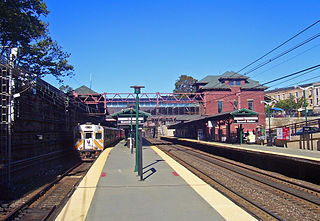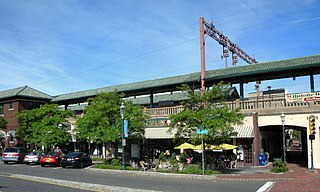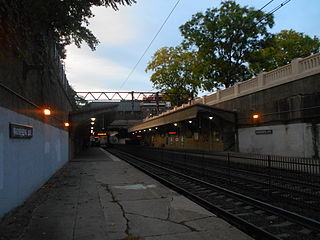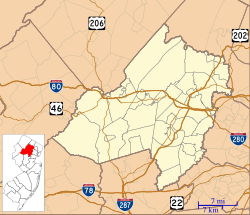
The Delaware, Lackawanna and Western Railroad, also known as the DL&W or Lackawanna Railroad, was a U.S. Class 1 railroad that connected Buffalo, New York, and Hoboken, New Jersey, and by ferry with New York City, a distance of 395 miles (636 km). The railroad was incorporated in Pennsylvania in 1853, and created primarily to provide a means of transport of anthracite coal from the Coal Region in Northeast Pennsylvania to large coal markets in New York City. The railroad gradually expanded both east and west, and eventually linked Buffalo with New York City.

NJ Transit Rail Operations is the rail division of NJ Transit. It operates commuter rail service in New Jersey, with most service centered on transportation to and from New York City, Hoboken, and Newark. NJ Transit also operates rail service in Orange and Rockland counties in New York under contract to Metro-North Railroad. The commuter rail lines saw 45,838,200 riders in 2022, making it the third-busiest commuter railroad in North America and the longest commuter rail system in North America by route length.

The Morristown Line is an NJ Transit commuter rail line connecting Morris and Essex counties to New York City, via either New York Penn Station or Hoboken Terminal. Out of 60 inbound and 58 outbound daily weekday trains, 28 inbound and 26 outbound Midtown Direct trains use the Kearny Connection to Penn Station; the rest go to Hoboken. Passengers can transfer at Newark Broad Street or Summit to reach the other destination. On rail system maps the line is colored dark green, and its symbol is a drum, a reference to Morristown's history during the American Revolution.

Newark Broad Street station is a New Jersey Transit commuter rail and light rail station at 25 University Avenue in Newark, New Jersey. Built in 1903, the station's historic architecture includes an elegant clock tower and a brick and stone façade on the station's main building. In June 1984, the station was added to the National Register of Historic Places in recognition of its historical significance.

Summit is a train station in Summit, New Jersey, served by New Jersey Transit's Morris & Essex Lines. The station sits between Union Place on the north and Broad Street on the south, with station access via either side, and between Summit Avenue on the east and Maple Avenue on the west. Constructed in 1904–1905 by the Delaware, Lackawanna and Western Railroad in a mile-long open cut, it is one of the few NJ Transit stations with platforms below street level.

Orange is an active commuter railroad train station in the city of Orange, Essex County, New Jersey. One of two stops in the city, it is served by New Jersey Transit's Morris and Essex Lines: the Morristown Line to Hackettstown and the Gladstone Branch to Gladstone for trains from New York Penn Station and Hoboken Terminal. Orange station contains two low-level side platforms and three tracks.

Mountain is a New Jersey Transit station in upper South Orange, Essex County, New Jersey, United States, along the Morris and Essex. The station, built in 1915, was designed by Frank J. Nies. It has been listed in the New Jersey Register of Historic Places and National Register of Historic Places since 1984 and is part of the Operating Passenger Railroad Stations Thematic Resource.

South Orange is a New Jersey Transit station in South Orange, New Jersey along the Morris and Essex rail line. It is located in the business district of South Orange, near its town hall. It is one of two train stations in the township of South Orange, Mountain Station being the other near the township border. South Orange station was built by the Lackawanna Railroad in 1916.

Madison station is a NJ Transit station in Madison, New Jersey. It is located on the Morristown Line.

Denville is an active commuter railroad train station in Denville Township, Morris County, New Jersey. Located on Estling Road, the station contains three side platforms–two curved low-level platforms that service New Jersey Transit's Morristown Line, and a third that services their Montclair-Boonton Line. Both platforms on the Morristown Line contain miniature high-level platforms for handicap accessibility. Trains on both lines operate between Hoboken Terminal, New York Penn Station and Hackettstown. Heading westbound, the next station is Dover while the next station east on the Morristown Line is Mount Tabor. The next station east on the Montclair-Boonton Line is Mountain Lakes.

Dover is an active commuter railroad train station in the borough of Dover, Morris County, New Jersey. Located at the end of electric service, Dover station serves as a secondary terminal of NJ Transit's Morristown and Montclair-Boonton Lines. Non-electric service continues west to Hackettstown on both lines. The next station to the west is Mount Arlington while the next station to the east is Denville. Dover station consists of a single island platform, accessible for the handicapped.

Lake Hopatcong is a commuter railroad station for New Jersey Transit. The station, located in the community of Landing in Roxbury Township, Morris County, New Jersey, United States, serves trains for the Montclair-Boonton Line and Morristown Line at peak hours and on holiday weekends. Service from Lake Hopatcong provides to/from Hackettstown to New York Penn Station and Hoboken Terminal. The stop is located on the tracks below Landing Road next to the eponymous Lake Hopatcong. The station consists of one active and one abandoned side platform, along with a shelter on the active platform. There is no accessibility for handicapped persons under the Americans with Disabilities Act of 1990.

Netcong is an NJ Transit station in Netcong, in Morris County, New Jersey, United States. Located on Route 46 at Main Street in downtown Netcong, the small, 1-low level side platform station service passengers for the Morristown Line and the Montclair-Boonton Line. These lines provide service to Hoboken or to New York City via Midtown Direct on the Morristown Line at Dover station and Montclair-Boonton at Montclair State University station. Midtown Direct service can also be transferred at Newark Broad Street station in Newark. There is one track and one platform on the north side, adjacent to the station. NJ Transit maintains a substantial train servicing yard east of the Netcong station at Port Morris in Roxbury Township. Port Morris Yard is proposed to return as the junction of the Montclair-Boonton and Morristown lines for the Lackawanna Cut-Off line to Scranton. Transfers would be provided at Lake Hopatcong station in Landing.

Hackettstown is a New Jersey Transit station in Hackettstown, New Jersey. The station is located at the intersection of Valentine Street and Beatty Street and is the western terminus of the Morristown Line and the Montclair-Boonton Line, which both provide service to Hoboken Terminal or to Pennsylvania Station in Midtown Manhattan via Midtown Direct. Hackettstown station is the only active New Jersey Transit station in Warren County. The line from Hackettstown–Dover is diesel powered, requiring a transfer at Dover, Montclair State University or Newark Broad Street to an electrified train to New York Penn Station. Proposals exist of an extension of the Montclair-Boonton Line, including an extension to Washington and possibly Phillipsburg further along the Washington Secondary.

Watsessing Avenue station is a New Jersey Transit rail station in Bloomfield, New Jersey, along the Montclair-Boonton Line. It is located beneath the Bloomfield Police Benevolent Association meeting hall near the corner of Watsessing Avenue and Orange Street in Bloomfield. It is one of two stations on the line where the boarding platform is below ground level. The Watsessing station and the Kingsland station in Lyndhurst on the Main Line shared similar designs and were built about the same time.

Boonton is a NJ Transit station in Boonton, Morris County, New Jersey, United States along the Montclair-Boonton Line. It is located on Main Street, near Myrtle Avenue and I-287. The original 1905 station was built by architect Frank J. Nies who built other stations for the Delaware, Lackawanna and Western Railroad. Unlike most of his stations which tended to be massive Renaissance structures, Boonton station was built as a simple Prairie House design. The station house is now a bar, and was added to the National Register of Historic Places on July 13, 1977, two years before the establishment of New Jersey Transit and six years before becoming part of their railroad division.

Roseville Avenue was a transfer station on New Jersey Transit's Morris & Essex Lines in Newark, New Jersey, United States. The station was built by the Delaware, Lackawanna and Western Railroad in 1903 as part of a project to lower the tracks below the road surface to eliminate grade crossings. It serviced Newark's Roseville neighborhood. It once had two tracks on the Lackawanna mainline and two low-wall platforms, with an additional platform along the Montclair Branch. The station remained in service during most of the 20th century, until New Jersey Transit closed the station on September 16, 1984.

Ampere, formerly known as The Crescent, is a defunct stop on New Jersey Transit's Montclair-Boonton Line in the city of East Orange, Essex County, New Jersey, United States. A station was first built there in 1890 to service to new Crocker Wheeler plant in the district. The stop was named in honor of André-Marie Ampère, a pioneer in electrodynamics and reconstructed as a new Renaissance Revival station in 1908. Ampere was the second stop on the branch west of Newark Broad Street Station until 1984, when the Roseville Avenue station was closed. In June of that year, the station, along with 42 others, was entered into the National Register of Historic Places. In 1986, after continuous deterioration, New Jersey Transit demolished the westbound shelter built in 1921. The agency discontinued rail service to Ampere on April 7, 1991. The entire station was demolished in 1995.

Pocono Mountain is a proposed New Jersey Transit Rail Operations (NJT) station located in Coolbaugh Township, Monroe County, Pennsylvania and is part of a site that was formerly utilized as a summer camp. The proposed station site, which will include a 1,000-space surface parking lot, is located northwest of a multi-phased planned development for this area. Access will be from Pennsylvania Route 611 via Pocono Municipal Road/Mount Pocono Road and a local access road and the platform would be situated east of the track.

Port Morris Junction is the railroad connection between NJ Transit's Montclair-Boonton Line and the Lackawanna Cut-Off. Opened in 1911 by the Lackawanna Railroad, it is in the Port Morris, New Jersey section of Roxbury Township, New Jersey, south of Lake Hopatcong.

























